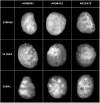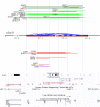Analysis of copy number variations among diverse cattle breeds
- PMID: 20212021
- PMCID: PMC2860171
- DOI: 10.1101/gr.105403.110
Analysis of copy number variations among diverse cattle breeds
Abstract
Genomic structural variation is an important and abundant source of genetic and phenotypic variation. Here, we describe the first systematic and genome-wide analysis of copy number variations (CNVs) in modern domesticated cattle using array comparative genomic hybridization (array CGH), quantitative PCR (qPCR), and fluorescent in situ hybridization (FISH). The array CGH panel included 90 animals from 11 Bos taurus, three Bos indicus, and three composite breeds for beef, dairy, or dual purpose. We identified over 200 candidate CNV regions (CNVRs) in total and 177 within known chromosomes, which harbor or are adjacent to gains or losses. These 177 high-confidence CNVRs cover 28.1 megabases or approximately 1.07% of the genome. Over 50% of the CNVRs (89/177) were found in multiple animals or breeds and analysis revealed breed-specific frequency differences and reflected aspects of the known ancestry of these cattle breeds. Selected CNVs were further validated by independent methods using qPCR and FISH. Approximately 67% of the CNVRs (119/177) completely or partially span cattle genes and 61% of the CNVRs (108/177) directly overlap with segmental duplications. The CNVRs span about 400 annotated cattle genes that are significantly enriched for specific biological functions, such as immunity, lactation, reproduction, and rumination. Multiple gene families, including ULBP, have gone through ruminant lineage-specific gene amplification. We detected and confirmed marked differences in their CNV frequencies across diverse breeds, indicating that some cattle CNVs are likely to arise independently in breeds and contribute to breed differences. Our results provide a valuable resource beyond microsatellites and single nucleotide polymorphisms to explore the full dimension of genetic variability for future cattle genomic research.
Figures




Similar articles
-
Impact of Parental Bos taurus and Bos indicus Origins on Copy Number Variation in Traditional Chinese Cattle Breeds.Genome Biol Evol. 2015 Aug 10;7(8):2352-61. doi: 10.1093/gbe/evv151. Genome Biol Evol. 2015. PMID: 26260653 Free PMC article.
-
Inter- and intra-breed genome-wide copy number diversity in a large cohort of European equine breeds.BMC Genomics. 2019 Oct 22;20(1):759. doi: 10.1186/s12864-019-6141-z. BMC Genomics. 2019. PMID: 31640551 Free PMC article.
-
Copy number variation of individual cattle genomes using next-generation sequencing.Genome Res. 2012 Apr;22(4):778-90. doi: 10.1101/gr.133967.111. Epub 2012 Feb 2. Genome Res. 2012. PMID: 22300768 Free PMC article.
-
Copy number variation in the cattle genome.Funct Integr Genomics. 2012 Nov;12(4):609-24. doi: 10.1007/s10142-012-0289-9. Epub 2012 Jul 13. Funct Integr Genomics. 2012. PMID: 22790923 Review.
-
An interpretive review of selective sweep studies in Bos taurus cattle populations: identification of unique and shared selection signals across breeds.Front Genet. 2015 May 13;6:167. doi: 10.3389/fgene.2015.00167. eCollection 2015. Front Genet. 2015. PMID: 26029239 Free PMC article. Review.
Cited by
-
Massive screening of copy number population-scale variation in Bos taurus genome.BMC Genomics. 2013 Feb 26;14:124. doi: 10.1186/1471-2164-14-124. BMC Genomics. 2013. PMID: 23442185 Free PMC article.
-
Analysis of copy number variations in the sheep genome using 50K SNP BeadChip array.BMC Genomics. 2013 Apr 8;14:229. doi: 10.1186/1471-2164-14-229. BMC Genomics. 2013. PMID: 23565757 Free PMC article.
-
Comparative analyses across cattle genders and breeds reveal the pitfalls caused by false positive and lineage-differential copy number variations.Sci Rep. 2016 Jul 6;6:29219. doi: 10.1038/srep29219. Sci Rep. 2016. PMID: 27381368 Free PMC article.
-
Copy Number Variation in Chickens: A Review and Future Prospects.Microarrays (Basel). 2014 Feb 5;3(1):24-38. doi: 10.3390/microarrays3010024. Microarrays (Basel). 2014. PMID: 27605028 Free PMC article. Review.
-
Detection of Runs of Homozygosity and Identification of Candidate Genes in the Whole Genome of Tunchang Pigs.Animals (Basel). 2024 Jan 8;14(2):201. doi: 10.3390/ani14020201. Animals (Basel). 2024. PMID: 38254370 Free PMC article.
References
-
- Adams DJ, Dermitzakis ET, Cox T, Smith J, Davies R, Banerjee R, Bonfield J, Mullikin JC, Chung YJ, Rogers J, et al. 2005. Complex haplotypes, copy number polymorphisms and coding variation in two recently divergent mouse strains. Nat Genet 37: 532–536 - PubMed
-
- Aitman TJ, Dong R, Vyse TJ, Norsworthy PJ, Johnson MD, Smith J, Mangion J, Roberton-Lowe C, Marshall AJ, Petretto E, et al. 2006. Copy number polymorphism in Fcgr3 predisposes to glomerulonephritis in rats and humans. Nature 439: 851–855 - PubMed
-
- Bauters M, Van Esch H, Friez MJ, Boespflug-Tanguy O, Zenker M, Vianna-Morgante AM, Rosenberg C, Ignatius J, Raynaud M, Hollanders K, et al. 2008. Nonrecurrent MECP2 duplications mediated by genomic architecture-driven DNA breaks and break-induced replication repair. Genome Res 18: 847–858 - PMC - PubMed
Publication types
MeSH terms
Associated data
- Actions
Grants and funding
LinkOut - more resources
Full Text Sources
Molecular Biology Databases
